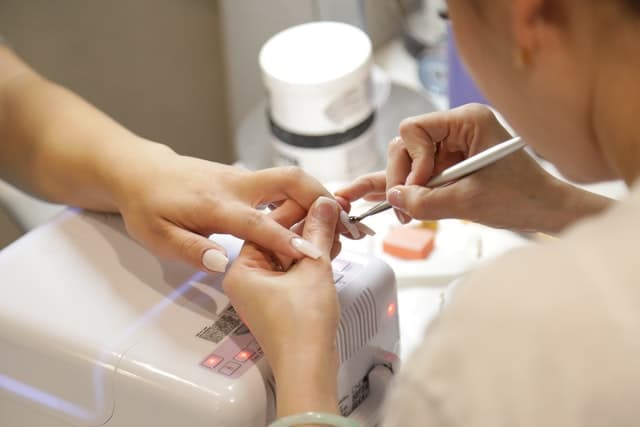If choosing between gel extensions and acrylic extensions, which should you go for? And what are nail extensions in the first place? Let’s have a look at answering those questions!
What Are Nail Extensions?
Nail extensions are artificial nail enhancements. Instead of applying a regular polish that covers your natural nail, or gluing on fake nails, you build up a nail using either acrylic or gel. With hard gel and gel builder you need tips or nail forms underneath to create extensions, while with acrylic and polygel you use a putty to shape the extensions on top of your natural nail.
For anyone with a penchant for biting their nails, or for people with brittle nails, nail extensions can be an eye opener.
Things You Should Know Before Getting Nail Extensions
Whether you’re going for gel or acrylic nail extensions, there are things you should know before getting nail extensions.
The first rule of nail extensions is to have them made by a professional. While you can do it at home, unless you get training to do so, chances are you’ll end up hurting your nails.
Nail extensions get better and better with the years, and with a trained nail technician applying and removing the nail extensions, they should not cause damage to your nails. That said, overuse is still not recommended. You need to take breaks from nail extensions from time to time to give your nails some breathing space. A god nail technician can let you know when it’s time to take that breather.
One thing to bear in mind, is that poorly done nail extensions can cause fungal infections if you expose your hands to water for any extended period of time. Something as simple as doing the dishes could cause this. A good nail technician, on the other hand, ensures the extensions are done properly so that water can’t get into places it shouldn’t. Which is another reason to always let professionals handle your nail extensions.
Even with the best nail technicians, it wouldn’t be recommended that you get nail extensions if you go swimming for an hour every day.
Now, let’s have a look at acrylic tips.
What Are Acrylic Nail Extensions?
Acrylic nails are made by mixing a powder (polymer) with a liquid (monomer). This forms a sort of paste that the nail technician shapes as and how you’d like it. If you want to change the shape of your nails, then acrylic is what you need.
Acrylic nails are also very hard, so for people who have soft and splitting nails, they may be the better option.
Once the nail technician has applied the acrylic nail, it air dries (the so-called “curing time”). This curing time is longer than that of gel nails.
When the acrylic extensions have dried, the nail technician paints them with nail polish—any kind of nail polish will work.
When you want to remove the extensions, it’s time to come back to the salon. While you can do it yourself, it may cause damage to the nail bed. A nail technician will soak the nails in a solution to be able to remove the acrylic extensions, as well as use files to do so. If you, do it yourself and tear off the nail too soon, it can cause layers of keratin to be removed with it, damaging the nail.
What are Gel Nail Extensions?
Gel nail extensions are softer and more flexible than acrylic nails, so perfect for people with hard, brittle nails that need to become more flexible to avoid breakage.
Gel nails last about two weeks—a little bit shorter than acrylic nails. However, if you get top-ups, they can last for another two weeks. Also, bear in mind that while acrylic nails are harder, gel nails are more flexible. So, it depends on how you use your hands what extensions are best for you.
While you can remove gel nails at home, it must be done properly, or you stand a risk of destroying your nails.
Polygel & Gel Builders : The New Techniques
Above we’ve explained traditional gel nails, but there are new techniques on the market today that are making incredible things possible!
Polygel is a hybrid formula that integrates the durability of acrylic nails and the elasticity of gel nails. It’s a mixture of gel and acrylic powder and comes in a tube.
With polygel, you can build and shape a nail the way you can with acrylic. In other words, it’s a putty you apply to the nail and then shape as you like. Just as with gel polish, you need a light to cure it and it dries extremely fast.
As the putty itself isn’t colored, you need to apply polish—whether regular polish or gel polish once the shape is in place.
If you want long nails, you have to use a nail form on top of your natural nail before applying the polygel but a refill will not be possible with polygel or builder gel.
Builder gels are very similar—like polygel they combine the strength of an acrylic nail with the flexibility of a gel nail. The difference is that builder gels come as liquids, while the polygels are putties. Meaning you can’t shape the nail using a builder gel alone—you need paper forms or tips.
What are types of nail polishes : Classic or Gel
You can use regular polish or gel polish no matter what extensions you go for.
Gel polish needs to be cured after each layer—this is done by holding your hands under an LED or UV light to activate the gel so that it hardens. However, some gels cure with a gel-activator and no light is needed. Ask your nail technician beforehand what gels she is using.

Gel polish dries extremely fast and won’t smudge, so unlike regular polish, you don’t have to worry about avoiding touch for about an hour after application.

Gel polish can last for about two weeks without chipping, so it lasts longer than regular polish. Usually, it also costs more.
Summary
As a general rule gel nails are more flexible than acrylic nails. Both are great for nail extensions. Acrylics, however, are better suited for very long nail extensions as they are harder. Polygels and builder gels offer a happy medium—the flexibility of gel nails and the durability of acrylic nails.
Nail extensions last longer than regular polish and usually you don’t have to redo the nail when it first starts to grow out—you can go for re-fill.
Nail extensions are not suitable for prolonged exposure to water and should be applied and removed by professionals to avoid allergic reactions and damage to the nail and cuticles














